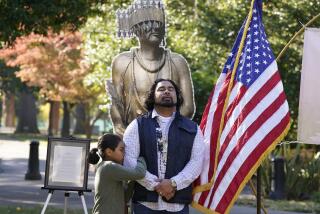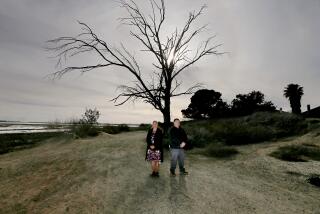Linguist’s Notes Are Only Clues to the Past
- Share via
The Chumash Indians were the first indigenous people the Spanish encountered in what is now California, historians say, and they were the most advanced in technology, commerce and material prosperity.
But hardly anybody bothered to take notes. In 1923, pioneering anthropologist A.L. Kroeber wrote: “There is no group in the state that once held the importance of the Chumash concerning which we know so little.”
Just as the last of the full-blooded Chumash were dying out, however, a linguist and ethnographer named John Peabody Harrington came along to learn their language, take down their recollections and record their songs.
“Much of what we know is thanks to Harrington,” said John Johnson, curator of anthropology at the Santa Barbara Museum of Natural History.
Harrington, who grew up in Santa Barbara and worked for the Smithsonian Institution, spent most of his life with the Chumash, Johnson said. One of his most important Chumash sources was Fernando Librado, who was born about 1840 on the west side of Santa Cruz Island.
When Librado was a child, Johnson said, he and his parents moved to the mission in Ventura, so Librado learned both the Ventureno and island dialects of the Chumash language. Harrington took Librado all over Ventura and Santa Barbara counties, jarring his memory about such things as village locations and historical vignettes. Some of them are recorded in “The Eye of the Flute,” Harrington’s account of Librado’s life.
Librado also showed Harrington how the Chumash--the only California Indians who routinely took to the sea--built their canoes, examples of which are on display at the Santa Barbara museum and the Albinger Archaeological Museum in Ventura.
Harrington made wax cylinder recordings of Librado singing, recordings that modern Chumash including Vincent Tumamait are using to learn ancient songs. From Harrington’s prolific notes--as many as 300,000 pages, Johnson said--Tony Romero of the Chumash Reservation is reconstructing dances.
Librado, who worked as a shepherd near Lompoc for most of his life, died in 1915.
Harrington worked with three generations of one family: Luisa Ignacio; her daughter, Lucrecia Garcia; and her granddaughter, Mary Yee.
Yee died in 1965--four years after Harrington’s death. She was the last speaker of the Chumash language, Johnson said, but she passed on a wealth of stories to her daughter, Ernestine McGovran of Santa Paula, who shares them at public presentations.
The Chumash were not organized as a united nation but as groups of villages that spoke dialects of the same language, anthropologists say. Each group of villages was under the command of a wot, or captain.
Unlike other California Indians, which identified themselves by clans, a Chumash would probably identify himself by his village--”a reflection of the higher population density, probably the highest in California,” Johnson said.
The word Chumash means “moneymakers,” after the Chumash specialty of making money from clamshells. The Chumash were prolific traders, and their money has been found as far away as Arizona.
To the Spanish, the Chumash “seemed more like their own people,” Johnson said. “They liked the fact that the Chumash had settled towns, higher political unity, beautiful plank boats that went back and forth to the islands.”
Anthropologists still know little about Chumash religious beliefs or ceremonies, but Kroeber said they were probably the only California Indians to bury their dead, which accounts for the frequent discovery of Chumash grave sites.
More to Read
Sign up for Essential California
The most important California stories and recommendations in your inbox every morning.
You may occasionally receive promotional content from the Los Angeles Times.










